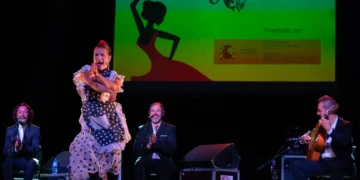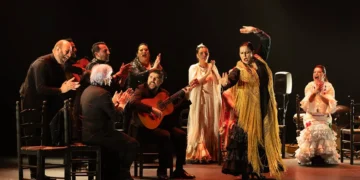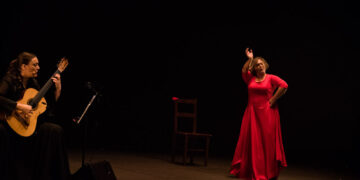 16th Festival de Jerez 2012 16th Festival de Jerez 2012
Pastora Galván “Pastora”
|
|
Text: Estela Zatania HABÍA UNA VEZ… FLAMENCO Dance: Pastora Galván. Guitar: Ramón Amador. Cante: Cristián Guerrero, José Valencia. Palmas, compás: Bobote. Idea, choreography and music director: Israel Galván. Not that many years ago, if you wanted to put together a flamenco work (then called a “show”), the first thing you had to do was get into a studio, with or without a guitarist (the singer would go the last day of rehearsal just to make possibly needed adjustments), and you would spend many hours every day in front of the mirror until all the pieces (then called “dances”) were choreographed (then, “mounted”). In the new millennium things have changed. Now, go find yourself a script-writer, contract one or more choreographers, a stage director, lighting designer, etc. The looming question, and certainly one which has no easy answer, is whether these changes have been beneficial, and if so, in what way and for whom? At the previous day’s press conference to present the work “Pastora”, Pastora Galván pointed out several times that Israel had choreographed the entire work. It’s only logical. When your brother is the most revolutionary and original dancer on the currrent scene, why not depend on his wisdom and vision. Don’t forget that in 2006, Pastora Galván achieved her artistic coming of age with the work “La Francesa”, a perfect jewel of theatrical flamenco which was overseen by her creative brother. Last night she won us over with the first number. Dressed as a frumpy Triana housewife, complete with housedress and apron, dancing on a cheesy throw rug, she conjured up a caricature of how they used to dance in Triana when the Cava de los Gitanos was a reality and a way of life. She exaggerates, it’s true, but it’s only to be expected that a young woman who didn’t experience those times of the patios and neighbors gathered round, would have a distilled mental image; the provocative movements with hips thrust forward (to put it delicately), or making fun of a disabled person (there’s no way to put it delicately) is what we most associate with Triana oldtimers, but there was also subtlety, good humor and plenty of compás, elements which are not absent in this show. Singer José Valencia, an institution in all the main dance companies, adds his flamenco voice and Lebrija cante. The solid guitar of Ramón Amador is certainly an important element. The little-known, but interesting young singer Cristián Guerrero sings marianas for Pastora’s tango dance, and she also moves to the sound of pregones free of compás and guitar, an experiment still waiting to come together. A siguiriya dance with the odd insertion of a fandango of Gloria, returns immediately to siguiriyas. There is also sevillanas, to guitar without voice or danced with Bobote, malagueña del Mellizo with abandolao, taranta, alegrías with Pastora in a red bata de cola and featuring the surreal intervention of Bobote, as well as tangos. And towards the end, a nearly complete catalogue of Galvanic movements, even including some chair experimentation, which is when the standard flamenco fan starts to peek at the clock, while lovers of good theater begin to applaud all the more enthusiastically. This is the second time this particular work of Pastora Galván has been featured at the Festival de Jerez. In 2009 we saw a beta version, nearly identical to last night’s in structure, cast and overall approach; we also saw the updated version at the Festival de Nimes in 2010. And the same thought has been hanging in the air since the first day: if only the extraordinary Pastora Galván would blaze her own path and not depend so much on her brother. She has plenty of training and preparation, she has a name of her own and is one hell of a dancer. |
Descubre más desde Revista DeFlamenco.com
Suscríbete y recibe las últimas entradas en tu correo electrónico.



























